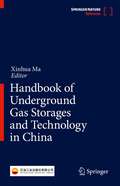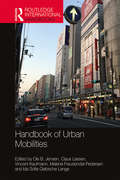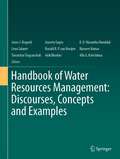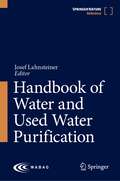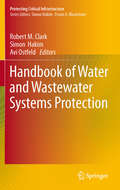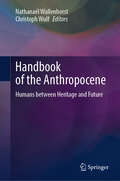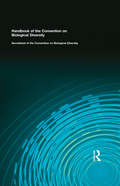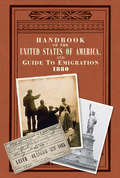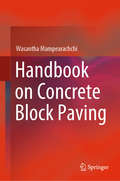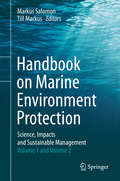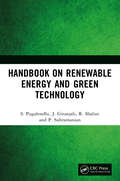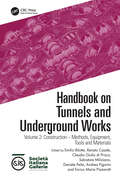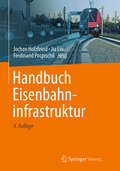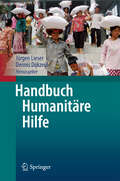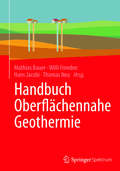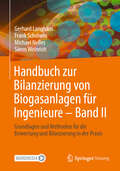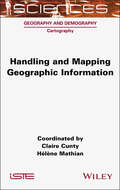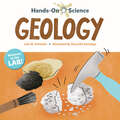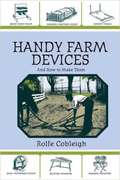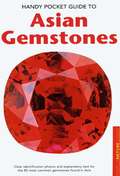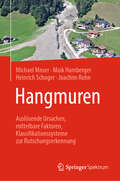- Table View
- List View
Handbook of Underground Gas Storages and Technology in China
by Xinhua MaThis book summarizes achievements and technology of China's underground gas storage in the past 20 years based on years of experience and technology accumulated in the construction and operation of gas storages. It also analyses and projects the future construction of underground gas storages in China Readers can systematically understand the construction status of China's underground gas storages, the difficulties encountered and the process and solution to such difficulties. It provides important theoretical and technical guidance for both in China and the world. Features of this book are listed as 1. Understand the development history, construction status, development trend of the underground gas storages around the world with countries and regions listed as case studies. 2. Understand the market demand of China's underground gas storages and resource distribution. 3. Understand the underground gas storages already built in China. 4. Understand the integrity management and risk control of the gas storages in China. 5. Understand the operation and management mode of gas storage. The target audience are those engaging in the research and technical management of the underground gas storage. It’s a valuable reference for both reseachers and college students as well in the fields of underground storage of carbon dioxide (CO2) and helium (He), Power to Gas energy accumulation.
Handbook of Urban Mobilities (Routledge International Handbooks)
by Ole B. JensenThis book offers the reader a comprehensive understanding and the multitude of methods utilized in the research of urban mobilities with cities and ‘the urban’ as its pivotal axis. It covers theories and concepts for scholars and researchers to understand, observe and analyse the world of urban mobilities. The Handbook of Urban Mobilities facilitates the understanding of urban mobilities within a historic conscience of societal transformation. It explores key concepts and theories within the ‘mobilities turn’ with a particular urban framework, as well as the methods and tools at play when empirical, urban mobilities research is undertaken. This book also explores the urban mobilities practices related to commutes; particular modes of moving; the exploration of everyday life and embodied practices as they manifest themselves within urban mobilities; and the themes of power, conflict, and social exclusion. A discussion of urban planning, public control, and governance is also undertaken in the book, wherein the themes of infrastructures, technologies and design are duly considered. With chapters written in an accessible style, this handbook carries timely contributions within the contemporary state of the art of urban mobilities research. It will thus be useful for academics and students of graduate programmes and post-graduate studies within disciplines such as urban geography, political science, sociology, anthropology, urban planning, traffic and transportation planning, and architecture and urban design.
Handbook of Water Resources Management: Discourses, Concepts and Examples
by Joyeeta Gupta Anik Bhaduri Janos J. Bogardi K. D. Wasantha Nandalal Léna Salamé Ronald R. P. van Nooijen Navneet Kumar Tawatchai Tingsanchali Alla G. KolechkinaThis book provides an overview of facts, theories and methods from hydrology, geology, geophysics, law, ethics, economics, ecology, engineering, sociology, diplomacy and many other disciplines with relevance for concepts and practice of water resources management. It provides comprehensive, but also critical reading material for all communities involved in the ongoing water discourses and debates.The book refers to case studies in the form of boxes, sections, or as entire chapters. They illustrate success stories, but also lessons to be remembered, to avoid repeating the same mistakes. Based on consolidated state-of-the-art knowledge, it has been conceived and written to attract a multidisciplinary audience.The aim of this handbook is to facilitate understanding between the participants of the international water discourse and multi-level decision making processes. Knowing more about water, but also about concepts, methods and aspirations of different professional, disciplinary communities and stakeholders professionalizes the debate and enhances the decision making.
Handbook of Water and Used Water Purification
by Josef LahnsteinerThe book addresses the entire water cycle. The focus is on new technologies/processes (especially in high performance biological treatment), energy recovery, water recycling and reuse. Recommendations with regard to the right technologies/processes for specific situations are provided and a wide range of case studies, especially in emerging markets. In addition, the most modern water terminology with more positive connotations is used. This is especially important in the field of direct and indirect potable reuse (DPR and IPR respectively).
Handbook of Water and Wastewater Systems Protection
by Simon Hakim Avi Ostfeld Robert M. ClarkFollowing the events of 9/11, the Administrator of the US Environmental Protection Agency created the Water Protection Task Force (WPTF), which identified water and wastewater systems as a major area of vulnerability to deliberate attack. The WPTF suggested that there are steps that can be taken to reduce these vulnerabilities and to make it as difficult as possible for potential saboteurs to succeed. The WPTF recommended that be scrutinized with renewed vigor to secure water and wastewater systems against these possible threats. It also recommended that water and wastewater systems have a response plan in place in the event an act of terrorism occurs. The WPTF identified water distribution networks as an area of special vulnerability and highlighted the need for rapid on-line detection methods that are accurate and have a wide detection range. As a result of these recommendations novel technologies from various fields of science and engineering are now addressing water security issues and water and wastewater utilities are looking for innovative solutions. Once such technologies are available, there will be a rapid implementation process that will present many business opportunities for the private sector. However, in addition to terrorist threats water and wastewater systems are inherently vulnerable to natural disasters such as earthquakes and floods. This volume will address the problems associated with both intended terrorist attacks and natural disasters affecting water or wastewater systems. The book is divided into parts based on the kinds of threats facing water and wastewater systems: (1) a direct attack on water and wastewater infrastructure storage reservoirs, and distribution and collection networks; (2) a cyber attack disabling the functionality of the water and wastewater systems or taking over control of key components which might result in system failures; and (3) a deliberate chemical or biological contaminant injection at one of the water distribution system's nodes. It will examine unique plans, technological and managerial innovations for protecting such systems, and includes descriptions of projects that were implemented to respond to natural disasters. Case studies are presented that discuss existing projects and evaluate their performance, with an emphasis on providing guidelines and techniques that can be implemented by water and wastewater planners and managers to deal with natural and manmade disasters should they occur.
Handbook of the Anthropocene: Humans between Heritage and Future
by Christoph Wulf Nathanaël WallenhorstThis Handbook is a collection of contributions of more than 300 researchers who have worked to grasp the Anthropocene, this new geological epoch characterised by a modification of the conditions of habitability of the Earth for all living things, in its biogeophysical and socio-political reality. These researchers also sought to define a historical and prospective anthropology that integrates social, economic, cultural and political issues as well as, of course, environmental ones. What are the anthropological changes needed to ensure that our human adventure will be able to continue in the Anthropocene? And what are the educational and political issues involved?Anthropocene is fast becoming a widely-used term, but thus far, there been no reference work explaining the thoughts of the greatest experts of the present day on this subject (at the intersection of biogeophysical and socio-political knowledge). A scientific and political concept (but which is also the conceptual vehicle for conveying the scientific community's sense of concern), this complex term is explained by international experts as they reflect on scientific arguments taking place in earth system science, the social sciences and the humanities. What these researchers from different disciplines have in common is a healthy concern for the future and how to prepare for it in the Anthropocene and also the identification of possible anthropological changes. This Handbook encourages readers to immerse themselves in reflections on the human adventure through descriptions of our differing heritages and the future that is in the process of being written.
Handbook of the Convention on Biological Diversity
by Secretariat To CbdIn 1992, at the Earth Summit in Rio, the United Nations adopted the Convention on Biological Diversity (CBD) to agree international measures aimed at preserving the vital ecosystems and biological resources on which we all depend. This is the official handbook to the Convention and presents all the most important information about the CBD, including a guide to the decisions adopted and to ongoing activities. It is an essential resource for all the governments, intergovernmental agencies, NGOs and conservation bodies and researchers working in this area. Included with the book is a fully indexed and cross-referenced CD-ROM containing all the relevant background material to the Convention, linked to relevant decisions and other sources of information.
Handbook of the United States of America, 1880
by Lp BrockettAmerica's "golden door" welcomed a huge wave of European immigrants between the 1880s and the 1920s. Millions passed through the gateway of the Statue of Liberty and Ellis Island on their way to becoming Americans, and The Handbook of the United States is an authentic reproduction of one of the immigrants' most trusted resources-- a complete guide to the USA, including everything from the pay-rates of various trades to amusing statistics about what Americans ate, drank, and manufactured. Once the tool that helped thousands of Irish, Italian and Jewish immigrants use their drive and industriousness to succeed, today it provides new insights into the extraordinary circumstances of the immigrant experience and the new arrivals' remarkable contribution to making America a great global power.
Handbook on Concrete Block Paving
by Wasantha MampearachchiThis book provides a comprehensive overview of concrete block paving (CBP). Starting with the basics, such as the history, applications, advantages and limitations of CBP, it then discusses in detail the structural behavior, construction process, and design support conditions, covering topics like specifications for blocks and laying patterns, field performance and mix design for ICBP. Lastly, it examines good CBP practices and maintenance.
Handbook on Marine Environment Protection
by Till Markus Markus SalomonThis handbook is the first of its kind to provide a clear, accessible, and comprehensive introduction to the most important scientific and management topics in marine environmental protection. Leading experts discuss the latest perspectives and best practices in the field with a particular focus on the functioning of marine ecosystems, natural processes, and anthropogenic pressures. The book familiarizes readers with the intricacies and challenges of managing coasts and oceans more sustainably, and guides them through the maze of concepts and strategies, laws and policies, and the various actors that define our ability to manage marine activities. Providing valuable thematic insights into marine management to inspire thoughtful application and further study, it is essential reading for marine environmental scientists, policy-makers, lawyers, practitioners and anyone interested in the field.
Handbook on Renewable Energy and Green Technology
by P. Subramanian S. Pugalendhi J. Gitanjali R. ShaliniThis book is a collection and compilation of various principles of renewable energy technologies and explores how we can use the sun, wind, biomass, geothermal, tidal and water resources to generate energy in a more sustainable form. Each chapter begins with the fundamental theory behind each technology illustrated with clear figures to understand the principle and applications. It also explains the fundamentals of energy, including the transfer of energy, as well as the limitations of natural resources. Starting with solar and wind energy, the text illustrates how energy from the sun, wind and water is transferred and converted into electricity. Other chapters cover methods of energy conversion, biomass energy, biofuel production and other new and renewable sources of energy such as geothermal, hydro, tidal, and ocean energy. This book is a collection of various principles of renewable energy technologies and explores how we can use the sun, wind, biomass, geothermal, tidal and water resources to generate energy in a more sustainable form.
Handbook on Tunnels and Underground Works: Volume 1: Concept – Basic Principles of Design
by Emilio BilottaThe book provides a new, global, updated, thorough, clear and practical risk-based approach to tunnelling design and construction methods, and discusses detailed examples of solutions applied to relevant case histories. It is organized in three sequential and integrated volumes: Volume 1: Concept – Basic Principles of Design Volume 2: Construction – Methods, Equipment, Tools and Materials Volume 3: Case Histories and Best Practices The book covers all aspects of tunnelling, giving useful and practical information about design (Volume 1), construction (Volume 2) and best practices (Volume 3). It provides the following features and benefits: updated vision on tunnelling design, tools, materials and construction balanced mix of theory, technology and applied experience different and harmonized points of view from academics, professionals and contractors easy consultation in the form of a handbook risk-oriented approach to tunnelling problems. The tunnelling industry is amazingly widespread and increasingly important all over the world, particularly in developing countries. The possible audience of the book are engineers, geologists, designers, constructors, providers, contractors, public and private customers, and, in general, technicians involved in the tunnelling and underground works industry. It is also a suitable source of information for industry professionals, senior undergraduate and graduate students, researchers and academics.
Handbook on Tunnels and Underground Works: Volume 2: Construction – Methods, Equipment, Tools and Materials
by Enrico Maria Pizzarotti Daniele Peila Emilio Bilotta Renato Casale Salvatore Miliziano Andrea Pigorini di Prisco, Claudio GiulioThis book set provides a new, global, updated, thorough, clear, and practical risk-based approach to tunnelling design and construction methods, and discusses detailed examples of solutions applied to relevant case histories. It is organized in three sequential and integrated volumes: Volume 1: Concept – Basic Principles of Design Volume 2: Construction – Methods, Equipment, Tools and Materials Volume 3: Case Histories and Best Practices The book covers all aspects of tunnelling, giving useful and practical information about design (Vol. 1), construction (Vol. 2), and best practices (Vol. 3). It provides the following features and benefits: updated vision on tunnelling design, tools, materials, and construction balanced mix of theory, technology, and applied experience different and harmonized points of view from academics, professionals, and contractors easy consultation in the form of a handbook risk-oriented approach to tunnelling problems The tunnelling industry is amazingly widespread and increasingly important all over the world, particularly in developing countries. The possible audience of the book are engineers, geologists, designers, constructors, providers, contractors, public and private customers, and, in general, technicians involved in the tunnelling and underground works industry. It is also a suitable source of information for industry professionals, senior undergraduate and graduate students, researchers, and academics.
Handbuch Betriebliches Umweltmanagement
by Gabi Förtsch Heinz MeinholzIn kompakter Form stellt dieses Handbuch das notwendige Wissen für das betriebliche, nachhaltige Umweltmanagement zur Verfügung. Es ist als Nachschlagewerk zur Einführung und Fortschreibung eines Umweltmanagementsystems konzipiert. Darüber hinaus kann es als Lehrbuch bzgl. der Grundaspekte des betrieblichen Umweltmanagements verwendet werden.
Handbuch Eisenbahninfrastruktur
by Jia Liu Jochen Holzfeind Ferdinand PospischilDie Eisenbahninfrastruktur weist eine große Anlagenvielfalt mit komplexen Wechselwirkungen auf. Diese Bandbreite und Komplexität von Bahnanlagen spiegelt das Nachschlagewerk mit Beiträgen von mehr als 50 Fachkräften aus allen Bereichen der Eisenbahninfrastruktur aus Deutschland und Österreich wider. Das Handbuch zeigt den erreichten Stand der Technik und berücksichtigt aktuelle Vorschriften. In den einzelnen miteinander vernetzten Kapiteln werden die technischen und operativen Grundlagen und Zusammenhänge der Eisenbahninfrastruktur sowie der Interaktion von Infrastruktur und Fahrzeug in Maß und Zahl dargestellt. Trassierung und Gleisplangestaltung, Eisenbahnoberbau, Kabelanlagen, Sicherheit, Instandhaltung und Anlagenmanagement sind nur einige der behandelten Fachgebiete. Die knappe aber fakten- und detailreiche Darstellung mit Bildern, Zeichnungen, Diagrammen und Tabellen ermöglicht einen schnellen Zugriff auf das gesuchte Wissensgebiet und die nachzuschlagenden Einzelheiten. Querverweise unterstützen das Verständnis der Komplexität und engen Vernetzung der verschiedenen Ingenieursdisziplinen auf dem Gebiet der Eisenbahninfrastruktur.Das Handbuch richtet sich an praktisch tätige Ingenieur*innen, Planungs- und Consultingingenieur*innen sowie an Führungskräfte und Entscheidungsträger in Unternehmen des Bahnsektors. Darüber hinaus eignet sich das Buch als umfassendes Nachschlagewerk für Studierende und Lehrende in Studiengängen des Verkehrs- und Bauingenieurwesens.
Handbuch Humanitäre Hilfe
by Jürgen Lieser Dennis DijkzeulMenschen, die infolge von Gewaltkonflikten oder Naturkatastrophen in eine humanitäre Notlage geraten sind, benötigen Hilfe. Diese ethische Selbstverständlichkeit hat mit der Gründung des Roten Kreuzes vor mehr als 150 Jahren einen institutionellen Rahmen bekommen. Seitdem ist die humanitäre Hilfe, also das organisierte und professionelle Helfen in humanitären Krisen und Katastrophen, stark gewachsen. Humanitäre Organisationen sind fast weltweit aktiv. In der Praxis erweist sich die humanitäre Hilfe als eine große Herausforderung. Hilfsorganisationen stehen unter einem hohen Erwartungs- und Zeitdruck: Sie sollen schnell, effektiv und reibungslos Hilfe zum Überleben leisten. Die Hilfe soll unparteiisch, neutral und nachhaltig sein und sich allein an den Bedürfnissen der betroffenen Menschen orientieren. Staatliche Geber, private Spender und auch die Hilfeempfänger verlangen Rechenschaft über den sinnvollen Einsatz der Hilfsgelder. Seit Jahren nehmen Naturkatastrophen in Zahl und Umfang zu. Gewaltkonflikte entwickeln sich zu chronischen Krisen mit einer Kriegswirtschaft, die es schwieriger macht, die Betroffenen zu unterstützen. Die Helferinnen und Helfer sehen sich konfrontiert mit zunehmend komplexeren Notlagen, divergierenden Geberinteressen, politischer Einflussnahme und konkurrierenden Hilfsangeboten. Sie geraten zwischen die Fronten und werden Opfer von gewaltsamen Übergriffen. Auch Missbrauch und politische Instrumentalisierung kommen vor. Dieses Buch trägt zu einem besseren Verständnis von humanitären Krisen und ihren Folgen bei. Es zeigt, wie sich die humanitäre Hilfe in einem internationalen System entwickelt hat und wie die verschiedenen Akteure ihre Rolle definieren und ausfüllen. Es zeigt auch, wie schwierig es ist, dem hohen ethischen Anspruch an unparteiische und von politischen Interessen unabhängige Hilfe gerecht zu werden. Die Autorinnen und Autoren - Vertreter von Hilfsorganisationen und Wissenschaft - zeigen aus unterschiedlichen Perspektiven auf, wie humanitäre Hilfe zwischen Anspruch und Wirklichkeit versucht, dem weltweit wachsenden Hilfebedarf gerecht zu werden.
Handbuch Oberflächennahe Geothermie
by Willi Freeden Mathias Bauer Hans Jacobi Thomas NeuDas Handbuch vermittelt die Grundlagen wie das thermische Regime der Erde, die oberflächennahe Geologie, geologisch-geophysikalische Grundlagen, zugrunde liegende mathematische Methoden, Risikomanagement und Bohrtechniken. In den angewandten Kapiteln geht es konkret um Geothermieprojekte aus der Sicht eines Bauherren, u.a. um Heizlastberechnung und die hydraulische Abgleichung, daneben um das Projektmanagement, zu berücksichtigende Umweltaspekte, Finanzierung und Fördermöglichkeiten und die Dimensionierung von Anlagen. Auch Verfahrenstechnische Grundlagen, die Maschinentechnik, die Qualitätssicherung und Fragen der Kommunikation und Akzeptanz wie auch der Arbeitssicherheit und des Gesundheitsschutzes werden behandelt. Auch wenn der Schwerpunkt des Handbuches auf Deutschland, Österreich und der Schweiz liegt, so wird auch auf die Oberflächennahe Geothermiebranche weltweit eingegangen und Herausforderungen wie auch Chancen und Perspektiven aufgezeigt.
Handbuch zur Bilanzierung von Biogasanlagen für Ingenieure - Band II: Grundlagen und Methoden für die Bewertung und Bilanzierung in der Praxis
by Gerhard Langhans Frank Scholwin Michael Nelles Sören WeinrichAus dem breiten Anwendungsfeld für Biogasgewinnung ergeben sich mannigfaltige Anforderungen, die den Praktiker oft vor spezielle Herausforderungen stellen. Hier setzt das Buch an und konzentriert sich auf die in der Praxis relevanten technischen Herausforderungen der Technologie und bereitet die wissenschaftlichen Grundlagen der anaeroben Prozessführung für Herausforderungen in der Praxis auf (Anwendbarkeit, Interpretation der Messgrößen, Zuverlässigkeit von Bewertungsmethoden) und stellt zur schnellen Abschätzung u. a. Nomogramme und Parametersammlungen zur Verfügung.
Handling and Mapping Geographic Information (ISTE Consignment)
by Hélène Mathian Claire CuntyWith the increasing proliferation of data and the systematization of geographic information referencing, maps are now a major concern – not only for specialists, but also for urban planning and development organizations and the general public. However, while producing a map may seem straightforward, the actual process of transforming data into a useful map with a specific purpose is characterized by a series of precise operations that require knowledge in a variety of fields: statistics, geography, cartography and so on. Handling and Mapping Geographic Information presents a wide range of operations based on a variety of examples. Each chapter adopts a different approach, explaining the methodological choices made in relation to the theme and the pursued objective. This approach, encompassing the entire map production process, will enable all readers, whether students, researchers, teachers or planners, to understand the multiple roles that maps can play in the analysis of geographical data.
Handling of Geospatial Data with QGIS: A Basic and Practical Visual Learning Material for Geospatial Data Processing, Analysis and Visualisation (Springer Textbooks in Earth Sciences, Geography and Environment)
by Yuji Murayama Ko Ko LwinThis textbook introduces QGIS software and shows how to use it step-by-step using many illustrations. Some topics can be understood by viewing a figure, without the need to read texts. The purposes, functions, and potential applications of the software are also explained. The book is a good first step to understand the theories on GIS through practice. With the increasing use of GIS (geographic information systems/science) in the arenas of education and research, the need for this book is becoming apparent. Students and researchers in various disciplines have noted that GIS is a powerful tool for acquiring, exploring, analyzing, and visualizing geospatial data for their work. Some of their data come from geospace in the form of coordinates; of course, we are living in a world with coordinates. Wherever we move, whatever we do, we can be located by coordinates, as everything is at rest, moving, or happening in space. Although GIS has been used for a long time in many professional fields, such as land surveying, urban and regional development, transportation planning, hydrology, environmental management, and so on, the use of GIS by the public is fairly recent. Following the emergence of global positioning systems, wireless communication technologies, and nano-scale microchip technologies, GIS is now a commonplace. Together with advanced technologies and user-friendly software development, the use of GIS has moved from desktop to laptop to mobile devices, and from professionals to academics to the public. Moreover, QGIS is increasingly used by students, researchers, and professionals on a daily basis due to its free and open-source geographic information system, community-based software development, user-friendliness, and the many plugins that are available to enhance the capabilities of this software.
Hands-On Science: Geology (Hands-On Science)
by Lola M. SchaeferPress Here meets Bill Nye the Science Guy in this interactive STEM picture book about rocks, minerals, and Earth science.Welcome to the geology lab! In this interactive picture book, young scientists use their imagination to bring experiments to life. They slide tectonic plates together to create earthquakes, blow on a mountain to make a volcano erupt, and press their hands in mud to make a fossil. After predicting what will happen next, eager readers turn the page to see the results.Educator and author Lola M. Schaefer draws on her years in the classroom to make science fun and accessible. Back matter includes a simple experiment for investigating rocks and minerals in the real world.
Handy Farm Devices and How to Make Them
by Rolfe CobleighDating from the Golden Age of American Farming, this volume is both a tribute to days gone by and a resource for present day homeowners, farmers, and ranchers striving toward greater self-sufficiency. Here you will find hundreds of clever ways to transform those odds and ends that might seem like junk into very useful gadgets and tools, from a treadmill that can power a dairy separator and churn, to a drinking fountain for chickens. Other devices include a rig for moving large trees; a self-feeder for bees; a hand garden cultivator; and gates that lift over snowdrifts. It's full of useful illustrations and includes a whole section of tried-and-true tips.
Handy Pocket Guide to Asian Gemstones
by Carol ClarkGemstones, both mythical and real, are deeply embedded in the arts, religions and cultures of Asia. This handy pocket guide provides an excellent introduction to the full range of superb gemstones mined and processed in the region, their physical characteristics, historical importance and countries of origin. Stunning color photographs and informative text by noted writer on gemstones Carol Clark, will delight both gem collectors and lovers of fine jewelry alike.
Handy Pocket Guide to Asian Gemstones
by Carol ClarkGemstones, both mythical and real, are deeply embedded in the arts, religions and cultures of Asia. This handy pocket guide provides an excellent introduction to the full range of superb gemstones mined and processed in the region, their physical characteristics, historical importance and countries of origin. Stunning color photographs and informative text by noted writer on gemstones Carol Clark, will delight both gem collectors and lovers of fine jewelry alike.
Hangmuren: Auslösende Ursachen, mittelbare Faktoren, Klassifikationssysteme zur Rutschungserkennung
by Michael Moser Joachim Rohn Maik Hamberger Heinrich SchogerDieses Buch bietet eine umfassende Analyse der Ursachen und Auswirkungen von Hangmuren, die durch Starkniederschläge ausgelöst werden, und untersucht dabei detailliert die geotechnischen und morphologischen Faktoren, die zu diesen Naturereignissen führen. Anhand von Fallstudien aus Kärnten, Tirol, der Schweiz und Norditalien werden die komplexen Zusammenhänge zwischen Niederschlagsereignissen und Hangbewegungen aufgezeigt. Wichtige Konzepte des Buches umfassen die geotechnischen Eigenschaften von Lockergesteinen, Hangneigung, Morphologie und Vegetation. Kapitel zu den auslösenden Ursachen, zu Geometrische Daten der Hangbewegungen und zu Stabilitätsbetrachtungen flachgründiger Lockergesteinsrutschungen beleuchten die Mechanismen hinter den Hangmuren. Zudem wird mit den Klassifikationssystemen zur Rutschungserkennung ein innovativer Ansatz zur Vorhersage und Erkennung von Rutschungen vorgestellt. Die Untersuchung der Ereignisse von 1965/66 im Lesachtal bis hin zu den jüngsten Hangmuren 2024 zeigt die Dringlichkeit und Relevanz dieses Themas. Die Zielgruppen des Buches sind Forscher, Geologen, Ingenieure und Fachleute im Bereich der Geotechnik sowie Entscheidungsträger in der Katastrophenvorsorge. Es bietet wertvolle Einblicke in die Mechanismen von Hangmuren und liefert praxisnahe Methoden zur Risikoanalyse und Prävention. Leser mit einem wissenschaftlichen oder technischen Hintergrund werden durch detaillierte Fallstudien und interdisziplinäre Ansätze profitieren. Sie lernen nicht nur die theoretischen Grundlagen kennen, sondern erhalten auch praktische Werkzeuge zur Anwendung in Forschung und Praxis.
